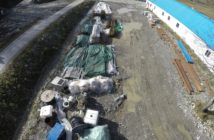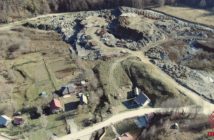The Montenegrin Government has not defined in the final version of the Detailed Spatial Plan (DSP) for the Thermal Power Plant Pljevlja all the locations where is planned disposal of ash and slag during the 40 years of operation of the new block, as far as it is projected its lifetime, but has resorted to short-term solutions to continue to dispose waste at the location Maljevac and opening of a new landfill in Sumani.
In the draft of the DSP, which was at a public hearing in May last year, for the landfill Maljevac it was clearly stated that “it is functioning despite construction instability and collapse presumed failure, and that “conditions of stability of the dam do not allow it to continue use above the level of 813 meters”, which is why there is a need to close and re-cultivate the landfill. The permitted height of the disposal of 813 meters has already been exceeded, and the Government in late 2014 signed a loan of $ 50 million with the World Bank, of which $ 4 million is planned for the closure of the site Maljevac.
However, the results suggested the instability of dam Maljevac have been deleted from the final version of the DSP, and it was added that previously were carried out reconstruction works in terms of stabilization of the dam. The DSP does not provide an answer to the question of landfill dangerousness, and separate documentation that MANS has revealed that the National Power Company of Montenegro (NPCMNE), which manages the landfill, plans to continue to dispose ash and slag on the free space next to the landfill, which calls Maljevac.
In fact, the inspection was carried out in this area in June last year and it was found that during deposition at the landfill Maljevac in the past was jeopardized transmission line, that in a part of the range has become available for people and animals, which represents a real danger and is necessary to relocate it. Inspection also assessed that the only way for further disposal is to create conditions at the remaining “free” space at the landfill Maljevac until a permanent location is created.
NPCMNE in the meantime entered into a negotiated procedure for the relocation of transmission line, and in February of this year with the Belgrade-based company “Energomontaza” signed a contract worth 750 thousand euros for the relocation of the transmission line, which will in fact create a space that in the upcoming years waste is disposed in the open space near the existing landfill Maljevac, and then close it.
When it comes to another location that is in the DSP planed for the disposal of waste is the location Sumani, a former coal mine Pljevlja where exploatation is completed. This location the NPCMNE in 2010 purchased for 7.5 million euros from the coal mine just for opening the landfill for ash and slag deposit.
However, during the public hearing for the DSP draft and in the media statements by representatives of energy companies and the Government started to mention the part of the open pit Potrlica, as a site for a new landfill, and the NPCMNE through a plan of public procurement for this year allocated nearly 600 thousand euros for the preparation of project documentation for Potrlica landfill, although there was no public debate for this location.
Selection Potrlice to be landfill, as coal mine pit, would at the same time allow the mining company not to perform re-cultivation of land and in this way save significant funds. In regard to this case MANS recently filed to the prosecutor’s office criminal charges against those responsible in the NPCMNE, because giving up the location Sumani would mean direct damage of 7.5 million how much was worth the purchase contract between NPCMNE and Coal Mine.
Judging by the final version of the DSP, in the meantime the Government returned to its original site in Sumani, and now is added a part which states that on this location will be made two landfills measuring 42 hectares, accumulation volume of 5.5 million cubic meters, which will provide space for waste disposal for about seven years, or even 14 years if the First block in the coming years operates with reduced power.
So, instead of defining all the potential sites for future landfill, the Government has resorted to short-term solutions, which further confirms the suspicion that unpripared entered the entire complex investment project, since previously were not offered answers to many questions, not only when it comes to locations for landfill, but particularly on the economic viability of the project.
Finally, we recall that in the final version of the DSP, the Government acknowledged that the deficit of electricity is no longer a key reason for building the Second block of the Thermal Power Plant. And how much is cost-effective production of electricity from Thermal Power Plants the best shows the situation from the beginning of this year, when the NPCMNE in February and March stopped the operation of the existing Thermal Power Plants, because it was cheaper to imports electricity from the region.
MANS and Green Home



